Geospatial Analysis of Regional Disparities in Non-Grain Cultivation: Spatiotemporal Patterns and Driving Mechanisms in Jiangsu, China
Abstract
1. Introduction
2. Materials and Methods
2.1. Study Area
2.2. Data Resources
2.3. Methods
2.3.1. Measurement of the “Non-Grainization” Level
2.3.2. Spatial Autocorrelation
2.3.3. Multiple Linear Regression and Mixed Geographically Weighted Regression
3. Results
3.1. Temporal Characteristics of Non-Grainization in Jiangsu Province’s Cultivated Land
- Increase–Decrease–Increase: Counties such as Wuxi and Taizhou had a pattern of rising, falling, and then rising non-grainization rates. For example, Wuxi’s non-grainization rate increased significantly to 56.69% between 2001 and 2003, then gradually decreased from 2003 to 2005, and finally increased rapidly to 83.35% by 2020 (Figure 5a).
- Continuous Increase: This pattern was mainly concentrated in southern Jiangsu, including Xishan District in Wuxi, Jiangyin, and Wujin District in Changzhou. Jiangyin’s non-grainization rate increased by 20.2% from 2001 to 2020 (Figure 5a).
- Stable: Some counties, such as Haian, Dongtai, and Danyang, experienced relatively stable non-grainization rates from 2001 to 2020 (Figure 5b).
- Increase–Decrease–Stable: Some counties, such as Suqian, Zhenjiang, and Lianyungang, had a rapid rise in non-grainization rates between 2001 and 2003, reaching a peak of 56.29% followed by a decline to 10.29% by 2008, with little variation thereafter (Figure 5c).
- Continuous Decrease: Some counties, such as Xuyi, Lianshui, and Hongze in Huai’an, showed a continuous decline in non-grainization rates, with Xuyi’s rate falling by 26.46% from 2001 to 2020 (Figure 5d).
3.2. Spatial Characteristics of Non-Grainization in Jiangsu Province
3.3. Analysis of the Factors Influencing the Non-Grainization of Cultivated Land in Jiangsu Province
4. Discussion
4.1. Analysis of the Factors Affecting the Non-Grainization Rate of Cultivated Land in Jiangsu Province and Regional Differences
4.2. Potential Impact of the Non-Grainization of Cultivated Land on China’s Food Security
4.3. Policy Implications
4.3.1. Cross-Regional Allocation of Food and Cash Crops, and the Establishment of a Provincial Compensation Mechanism
4.3.2. Integrating Land Transfer Management and Climate Adaptation for Sustainable Grain Production
4.3.3. Considering Regional Heterogeneity in Cultivated Land Management
- Increase–decrease–increase: Mainly concentrated in southern Jiangsu, with some areas in central Jiangsu. The non-grainization rate during the increase phase is generally much higher than the provincial average. Vigilance is required to curb the further spread of non-grainization. Measures such as the grain security responsibility system should be implemented to protect grain cultivation areas and strengthen the surveillance of “grain fields” converted to “non-grain fields” to ensure food security. A high standard of farmland construction should be promoted to maintain the cultivation area and improve farmland management. This would prevent farmers from abandoning grain for economic benefits.
- Continuous increase: Primarily in southern Jiangsu, where the proportion of grain-sown areas is generally below 60%. High-quality grain crop varieties should be promoted, with priority given to arable land use. In this region, high-quality arable land should be used for grain production.
- Increase–decrease–stable: Mainly occurs in municipal districts, which are the core components of urban areas and the centers of regional economic development. While developing tertiary industry, modern agriculture should also be vigorously developed to establish concentrated and contiguous high-yield grain production areas. This would ensure an effective supply of the major agricultural products, continuous income growth for farmers, and sustainable agricultural development.
- Stable: Classified treatment and scientific planning are required in these regions. For areas with non-grainization rates below the provincial average (e.g., Suqian and Lianyungang municipal districts), which have a strong foundation in grain production and a significant impact on food security, stable production rates and supply should be maintained. The production capacity of important agricultural products should be gradually improved. For areas with non-grainization rates above the provincial average, existing farmland planning should be adjusted, and the Party and government should take joint responsibility for food security.
- Continuous decrease: Most districts and counties in Huai’an displayed an overall decreasing trend. In 2022, 10.4% of Jiangsu’s arable land produced 12.9% of its grain. Therefore, all regions must resolutely reduce the unauthorized use of arable land, implement various strategies to enhance food security, and consistently enhance mechanisms for high-quality farmland construction.
4.4. Limitations of the Study
5. Conclusions
Supplementary Materials
Author Contributions
Funding
Data Availability Statement
Conflicts of Interest
References
- Prosekov, A.Y.; Ivanova, S.A. Food security: The challenge of the present. Geoforum 2018, 91, 73–77. [Google Scholar] [CrossRef]
- Beddington, J.R.; Crute, I.R.; Godfray, H.C.J. Food security: The challenge of feeding 9 billion people. Science 2010, 327, 812–818. [Google Scholar]
- Long, H.; Ge, D.; Zhang, Y.; Tu, S.; Qu, Y.; Ma, L. Changing man-land interrelations in China’s farming area under urbanization and its implications for food security. J. Environ. Manag. 2018, 209, 440–451. [Google Scholar] [CrossRef] [PubMed]
- Gao, M.; Chen, B.; Xu, Y.; Li, D. Heterogeneous impacts of global land urbanization on land-use structure from economic and technological perspectives. Ecol. Indic. 2023, 147, 109955. [Google Scholar] [CrossRef]
- Halperin, S.; Castro, A.J.; Quintas-Soriano, C.; Brandt, J.S. Assessing high quality agricultural lands through the ecosystem services lens: Insights from a rapidly urbanizing agricultural region in the western United States. Agric. Ecosyst. Environ. 2023, 349, 108435. [Google Scholar] [CrossRef]
- Mudapakati, C.P.; Bandauko, E.; Chaeruka, J.; Arku, G. Peri-urbanisation and land conflicts in Domboshava, Zimbabwe. Land Use Policy 2024, 144, 107222. [Google Scholar] [CrossRef]
- Deb, P.; Jha, R.K.; Kumar, N.; Vishal, M.K.; Shukla, D.P.; Kalita, P.K.; Singh, L.K. Analyzing land use land cover dynamics under rapid urbanization using multi-temporal satellite imageries and geospatial technology for Jamshedpur city in India. Adv. Space Res. 2025, 75, 2810–2825. [Google Scholar] [CrossRef]
- Okeleye, S.O.; Okhimamhe, A.A.; Sanfo, S.; Fürst, C. Impacts of Land Use and Land Cover Changes on Migration and Food Security of North Central Region, Nigeria. Land 2023, 12, 1012. [Google Scholar] [CrossRef]
- Zhai, J.; Pu, L.; Lu, Y.; Huang, S. Is the boom in staple crop production attributed to expanded cropland or improved yield? A comparative analysis between China and India. Sci. Total Environ. 2024, 933, 173151. [Google Scholar] [CrossRef]
- Gao, Y.; Yue, Y.; Yang, W. Correlating grain yield with irrigation in a spatio-temporal context on the North China Plain. Heliyon 2024, 10, e32745. [Google Scholar] [CrossRef]
- Zeng, K.; Zhai, Y.; Wang, L.; Wang, Y. Spatio-Temporal Differentiation of Non-Grain Production of Cropland and Its Influencing Factors: Evidence from the Yangtze River Economic Belt, China. Sustainability 2024, 16, 6103. [Google Scholar] [CrossRef]
- He, T.T.; Jiang, S.Q.; Xiao, W.; Zhang, M.; Tang, T.; Zhang, H. A non-grain production on cropland spatiotemporal change detection method based on Landsat time-series data. Land Degrad. Dev. 2024, 35, 3031–3047. [Google Scholar] [CrossRef]
- Zhang, D.; Yang, W.; Kang, D.; Zhang, H. Spatial-temporal characteristics and policy implication for non-grain production of cultivated land in Guanzhong Region. Land Use Policy 2023, 125, 106466. [Google Scholar] [CrossRef]
- Bhullar, A.; Nadeem, K.; Ali, R.A. Simultaneous multi-crop land suitability prediction from remote sensing data using semi-supervised learning. Sci. Rep. 2023, 13, 6823. [Google Scholar] [CrossRef]
- Hao, Q.; Zhang, T.; Cheng, X.; He, P.; Zhu, X.; Chen, Y. GIS-based non-grain cultivated land susceptibility prediction using data mining methods. Sci. Rep. 2024, 14, 4433. [Google Scholar] [CrossRef] [PubMed]
- Wu, Y.; Yuan, C.; Wei, W.X. Decoupling relationship between the non-grain production and intensification of cultivated land in China based on Tapio decoupling model. J. Clean. Prod. 2023, 424, 138800–138801. [Google Scholar] [CrossRef]
- Zhu, Z.Y.; Duan, J.J.; Li, S.L.; Dai, Z.; Feng, Y. Phenomenon of Non-Grain Production of Cultivated Land Has Become Increasingly Prominent over the Last 20 Years: Evidence from Guanzhong Plain, China. Agriculture 2022, 12, 1654. [Google Scholar] [CrossRef]
- Zhang, J.; Li, X.; Xie, S.; Xia, X. Research on the Influence Mechanism of Land Tenure Security on Farmers’ Cultivated Land Non-Grain Behavior. Agriculture 2022, 12, 1645. [Google Scholar] [CrossRef]
- Chen, S.C.; Zhang, Y.N.; Zhu, Y.L.; Ma, L.; Zhao, J. The battle of crops: Unveiling the shift from grain to non-grain use of farmland in China? Int. J. Agr. Sustain. 2023, 21, 2262752. [Google Scholar] [CrossRef]
- Li, Y.F.; Zhao, B.C.; Huang, A.; Xiong, B.; Song, C. Characteristics and Driving Forces of Non-Grain Production of Cultivated Land from the Perspective of Food Security. Sustainability 2021, 13, 14047. [Google Scholar] [CrossRef]
- Huang, J.; Wei, W.; Cui, Q.; Xie, W. The prospects for China’s food security and imports: Will China starve the world via imports? J. Integr. Agr. 2017, 16, 2933–2944. [Google Scholar] [CrossRef]
- Liu, M.X.; Lin, F.Q. The Impact of COVID-19Pandemic on the Resilience of China’s Agricultural Trade. Int. Econ. Trade Res. 2023, 39, 51–67. [Google Scholar] [CrossRef]
- Rivera-Ferre, M.G.; López-i-Gelats, F.; Ravera, F.; Oteros-Rozas, E.; di Masso, M.; Binimelis, R.; El Bilali, H. The two-way relationship between food systems and the COVID-19 pandemic: Causes and consequences. Agr. Syst. 2021, 191, 103134. [Google Scholar] [CrossRef]
- Stephens, E.; Timsina, J.; Martin, G.; van Wijk, M.; Klerkx, L.; Reidsma, P.; Snow, V. The immediate impact of the first waves of the global COVID-19 pandemic on agricultural systems worldwide: Reflections on the COVID-19 special issue for agricultural systems. Agr. Syst. 2022, 201, 103436. [Google Scholar] [CrossRef] [PubMed]
- Xu, J.L.; Ding, Y. Research on Early Warning of Food Security Using a System Dynamics Model: Evidence from Jiangsu Province in China. J. Food Sci. 2015, 80, R1–R9. [Google Scholar] [CrossRef]
- Jiangsu Provincial People’s Government. Jiangsu Statistical Yearbook 2021. Available online: https://tj.jiangsu.gov.cn/2021/indexc.htm (accessed on 27 July 2024).
- National Bureau of Statistics. China Population Census Yearbook 2020. Available online: https://www.stats.gov.cn/sj/pcsj/rkpc/7rp/indexch.htm (accessed on 23 March 2025).
- Guo, Y.; Wang, J. Identifying the Determinants of Nongrain Farming in China and Its Implications for Agricultural Development. Land 2021, 10, 902. [Google Scholar] [CrossRef]
- Hu, J.; Wang, H.; Song, Y. Spatio-Temporal Evolution and Driving Factors of “Non-Grain Production” in Hubei Province Based on a Non-Grain Index. Sustainability 2023, 15, 9042. [Google Scholar] [CrossRef]
- Yang, J.; Liu, Q.L.; Deng, M. Spatial hotspot detection in the presence of global spatial autocorrelation. Int. J. Geogr. Inf. Sci. 2023, 37, 1787–1817. [Google Scholar] [CrossRef]
- Hughey, S.M.; Kaczynski, A.T.; Porter, D.E.; Hibbert, J.; Turner-McGrievy, G.; Liu, J. Spatial clustering patterns of child weight status in a southeastern US county. Appl. Geogr. 2018, 99, 12–21. [Google Scholar] [CrossRef]
- Bashir, A.; Shehzad, M.A.; Hussain, I.; Rehmani, M.I.A.; Bhatti, S.H. Reservoir Inflow Prediction by Ensembling Wavelet and Bootstrap Techniques to Multiple Linear Regression Model. Water Resour. Manag. 2019, 33, 5121–5136. [Google Scholar] [CrossRef]
- Kamarianakis, Y.; Feidas, H.; Kokolatos, G.; Chrysoulakis, N.; Karatzias, V. Evaluating remotely sensed rainfall estimates using nonlinear mixed models and geographically weighted regression. Environ. Model. Softw. 2008, 23, 1438–1447. [Google Scholar] [CrossRef]
- Zhao, S.X.; Xiao, D.Y.; Yin, M.M. Spatiotemporal Patterns and Driving Factors of Non-Grain Cultivated Land in China’s Three Main Functional Grain Areas. Sustainability 2023, 15, 13720. [Google Scholar] [CrossRef]
- Su, Y.; Li, C.; Wang, K.; Deng, J.; Shahtahmassebi, A.R.; Zhang, L.; Ao, W.; Guan, T.; Pan, Y.; Gan, M. Quantifying the spatiotemporal dynamics and multi-aspect performance of non-grain production during 2000–2015 at a fine scale. Ecol. Indic. 2019, 101, 410–419. [Google Scholar] [CrossRef]
- Sun, Y.; Chang, Y.; Liu, J.; Ge, X.; Liu, G.J.; Chen, F. Spatial Differentiation of Non-Grain Production on Cultivated Land and Its Driving Factors in Coastal China. Sustainability 2021, 13, 13064. [Google Scholar] [CrossRef]
- Xu, C.; Guo, J.; Yi, J.; Ou, M.H. Analysis on the Evolution of Spatiotemporal Pattern and Driving Factors of Non-grain Cultivated land in Jiangsu Province from 1996 to 2020. Resour. Environ. Yangtze Basin 2024, 33, 436–447. [Google Scholar]
- Tran, T.Q.; Vu, H.V. The pro-poor impact of non-crop livelihood activities in rural Vietnam: A panel data quantile regression analysis. Econ. Anal. Policy 2020, 68, 348–362. [Google Scholar] [CrossRef]
- Dzanku, F.M. Household-specific food price differentials and high-value crop production in rural Ghana. Food Policy 2015, 57, 73–82. [Google Scholar] [CrossRef]
- Liu, H.; Chen, S. Empirical analysis of factors influencing farmers’ willingness to participate in small-scale farmland water conservancy construction—Based on a survey of 475 farmers in major grain-producing areas of Hunan Province. China Rural. Surv. 2012, 02, 54–66. [Google Scholar]
- Xia, L. Study on the Relationship Between Non-Grain Production of Cultivated Land and Rural Household Income Under the Background of the Rural Revitalization Strategy: Based on On-Site Research and Analysis in Xuanwei City, Yunnan Province. Master’s Thesis, Yunnan University of Finance and Economics, Kunming, China, 5 June 2023. [Google Scholar]
- Dai, C.; Liu, Y.; Wang, J. Revealing the process and mechanism of non-grain production of cropland in rapidly urbanized deqing County of China. J. Environ. Manag. 2025, 374, 123948. [Google Scholar] [CrossRef]
- Lou, S. What determines the investment intention of Chinese farmers in green grain production? Environ. Dev. Sustain. 2024, 26, 11217–11242. [Google Scholar] [CrossRef]
- Xiong, C.J.; Zhao, X.H. Impacts of chemical fertilizer reduction on grain yield: A case study of China. PLoS ONE 2024, 19, e0298600. [Google Scholar] [CrossRef] [PubMed]
- Xie, Y.; Wang, Z.; Wang, Y.; Zheng, J.; Xiang, S.; Gao, M. Spatial-temporal variation and driving types of non-grain cultivated land in hilly and mountainous areas of Chongqing. J. Agric. Resour. Environ. 2024, 41, 15–26. [Google Scholar] [CrossRef]
- Zheng, T.; Zhao, G.Q.; Chu, S.W. A Study on the Impact of External Shocks on the Resilience of China’s Grain Supply Chain. Sustainability 2024, 16, 956. [Google Scholar] [CrossRef]
- Oliveira, E.; Leuthard, J.; Tobias, S. Spatial planning instruments for cropland protection in Western European countries. Land Use Policy 2019, 87, 104031. [Google Scholar] [CrossRef]
- Linkous, E.R. Transfer of development rights in theory and practice: The restructuring of TDR to incentivize development. Land Use Policy 2016, 51, 162–171. [Google Scholar] [CrossRef]
- Zhang, X.Q. Research on the Construction of Inter-Provincial Horizontal Benefit Compensation Mechanism for Grain Production and Marketing Areas. Price Theory Pract. 2025. [Google Scholar] [CrossRef]
- Baldoni, E.; Ciaian, P. The capitalization of CAP subsidies into land prices in the EU. Land Use Policy 2023, 134, 106900. [Google Scholar] [CrossRef]
- Han, Z.; Xie, W.; Song, Y.; Sun, L.; Yu, H.; Chen, B.; Li, Y.; Wang, Y. A bottom-up nationwide analysis of sectoral land use reveals spatial heterogeneity across the United States. Resour. Conserv. Recycl. 2025, 212, 107969. [Google Scholar] [CrossRef]
- Punzo, G.; Castellano, R.; Bruno, E. Using geographically weighted regressions to explore spatial heterogeneity of land use influencing factors in Campania (Southern Italy). Land Use Policy 2022, 112, 105853. [Google Scholar] [CrossRef]
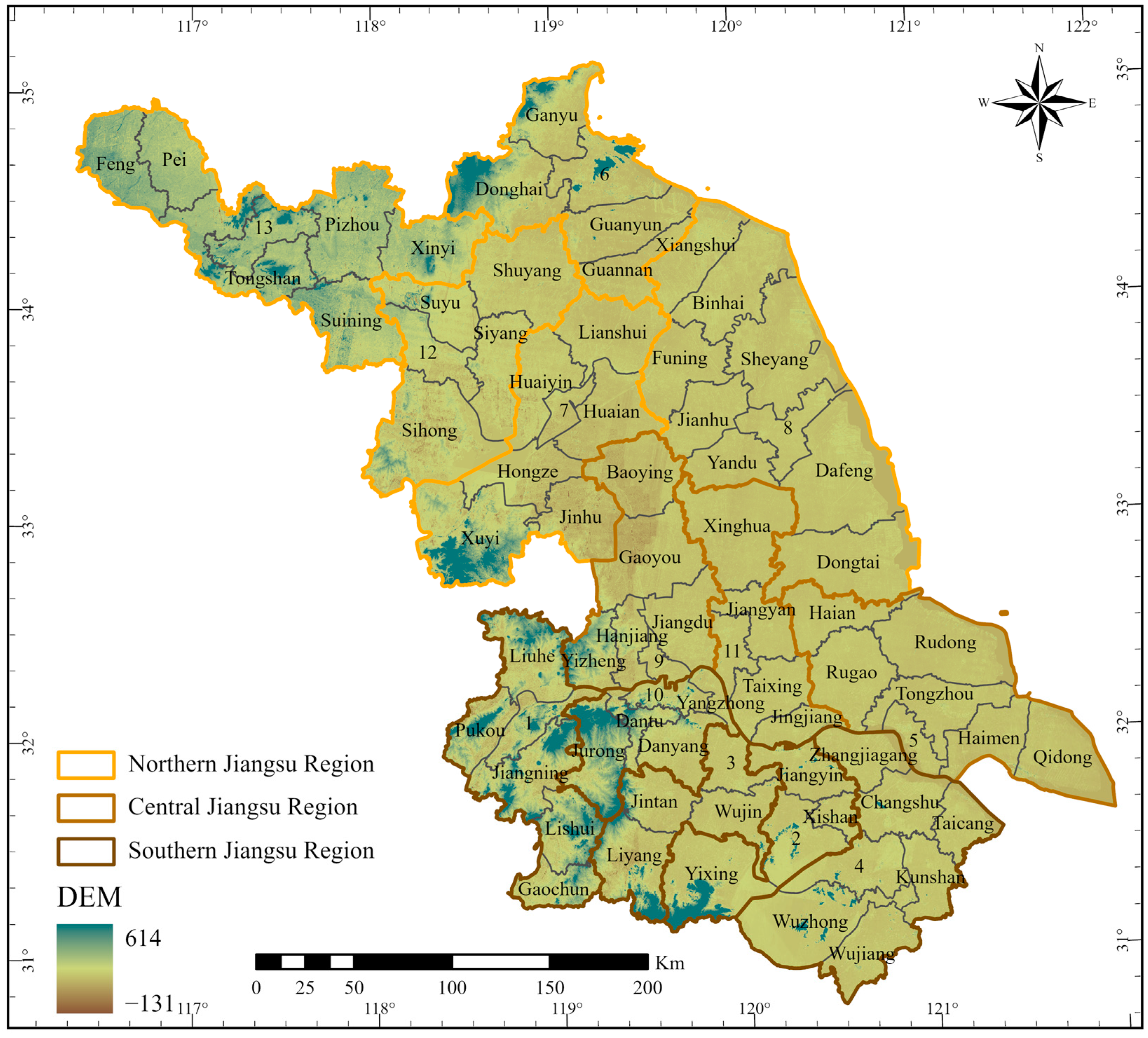
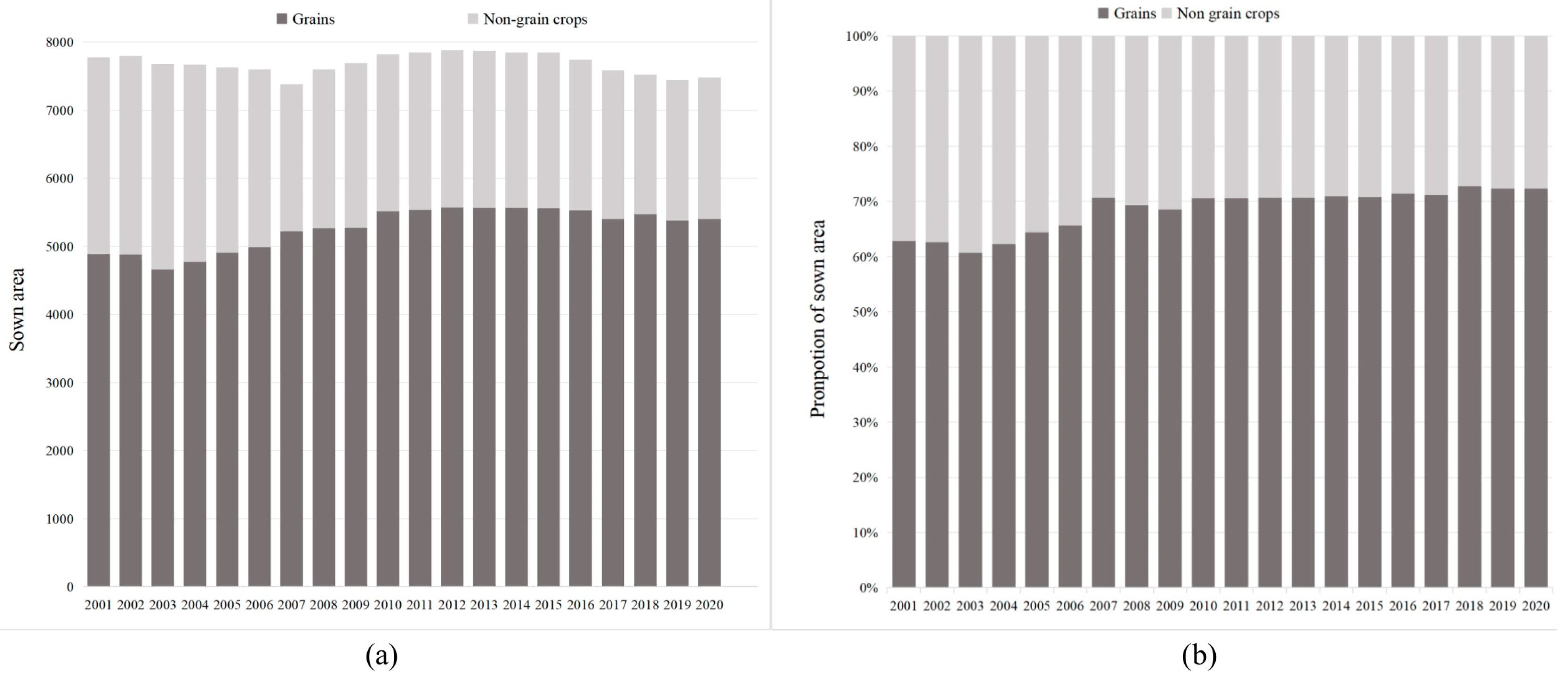
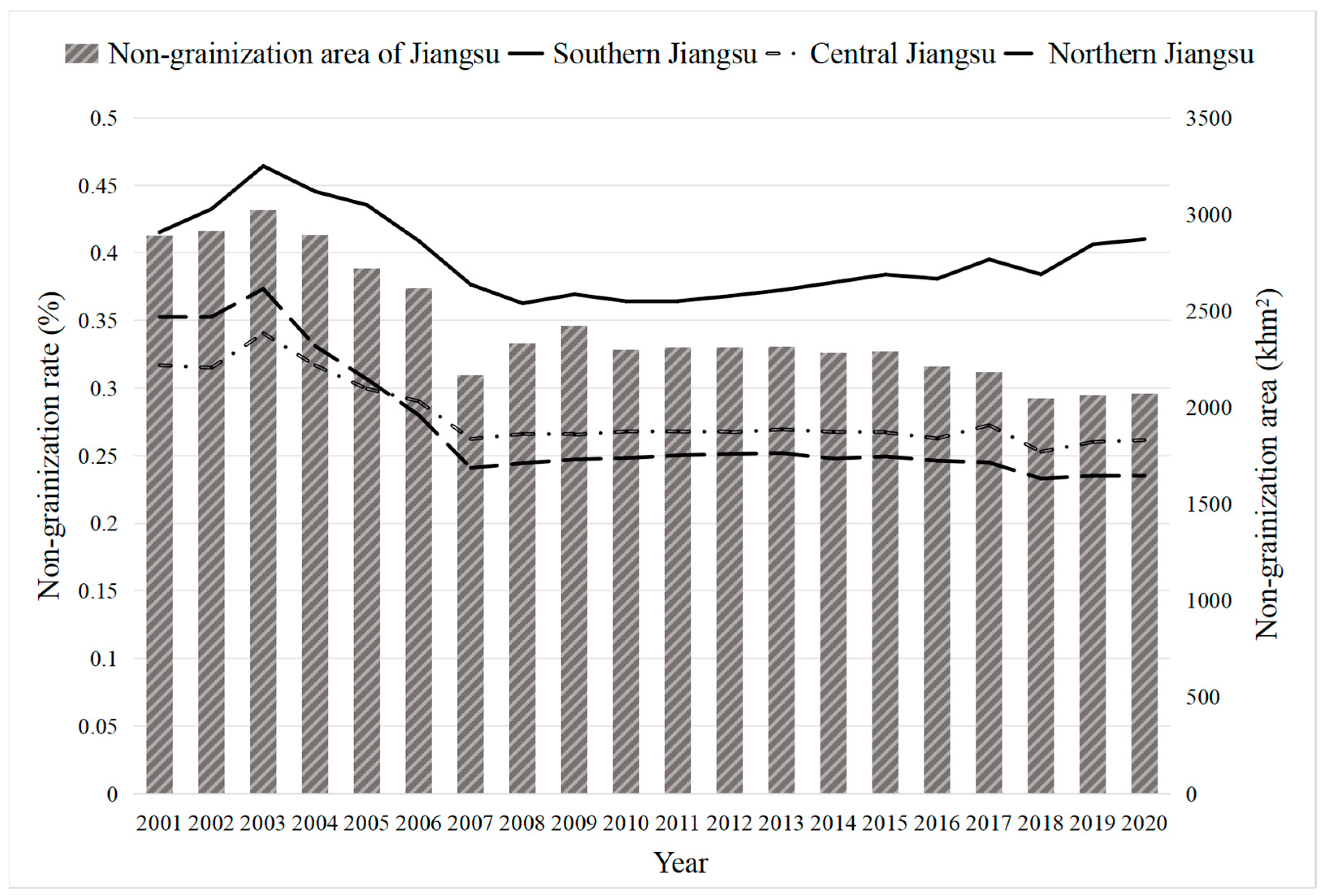
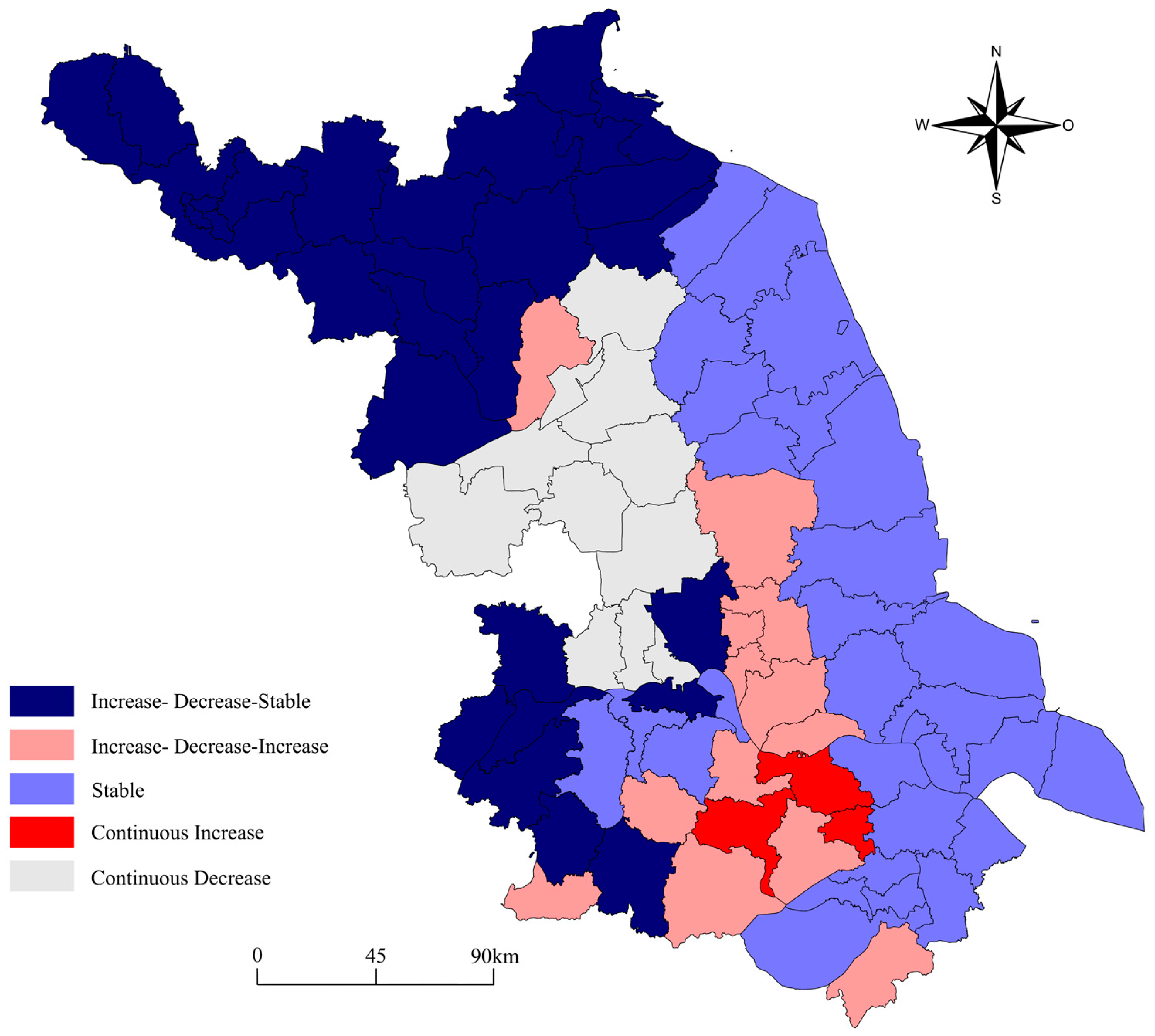
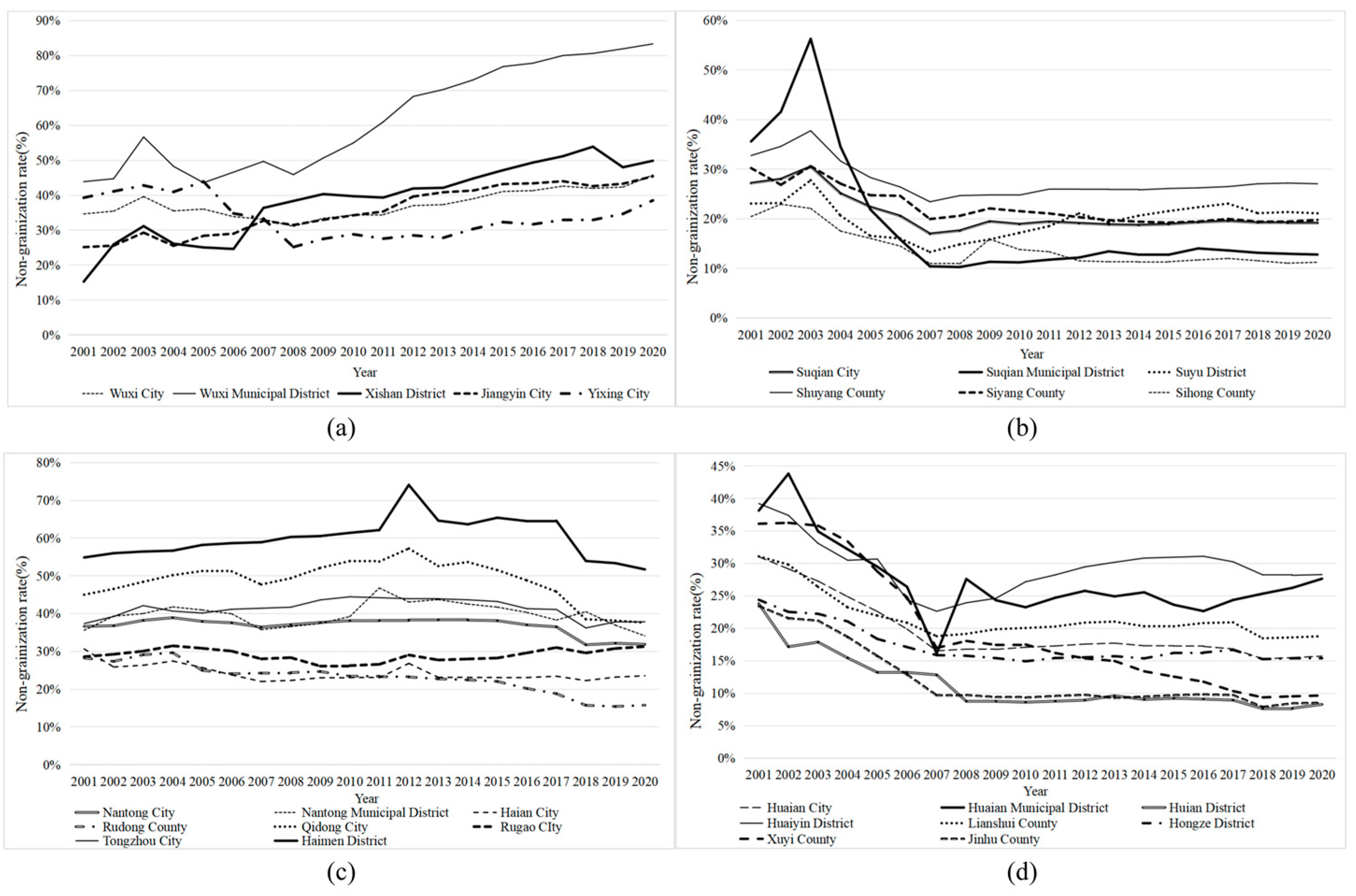
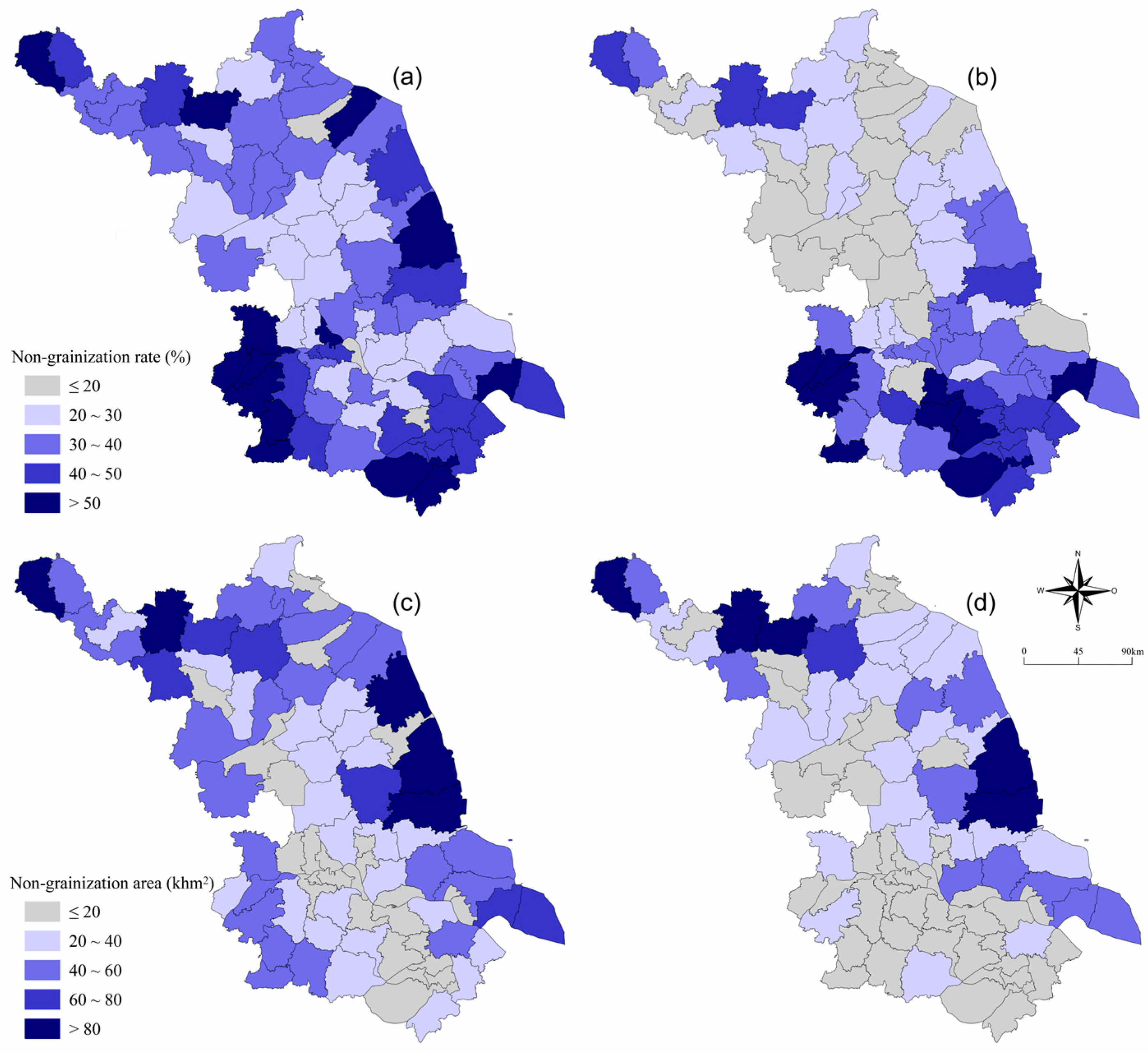
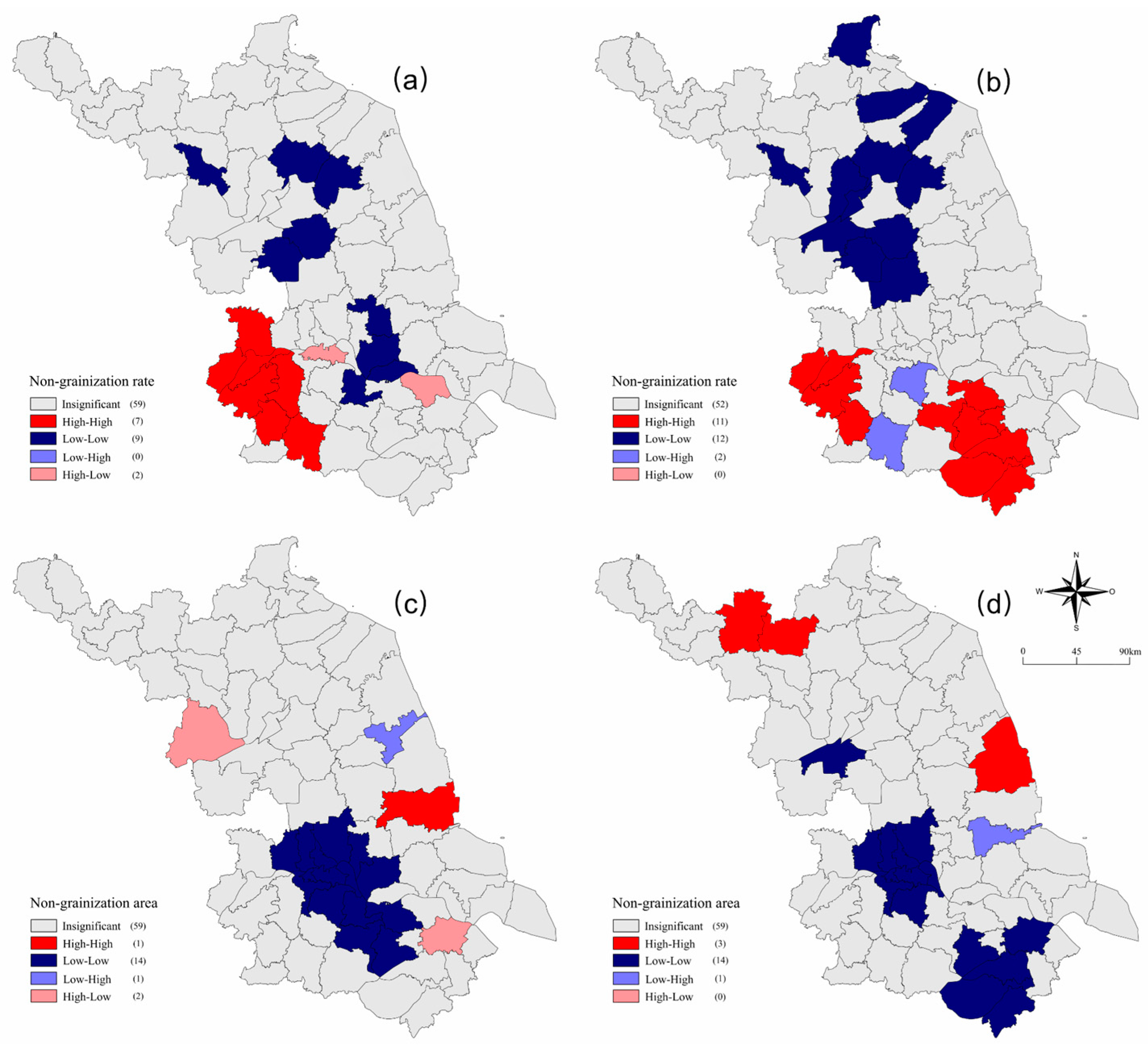
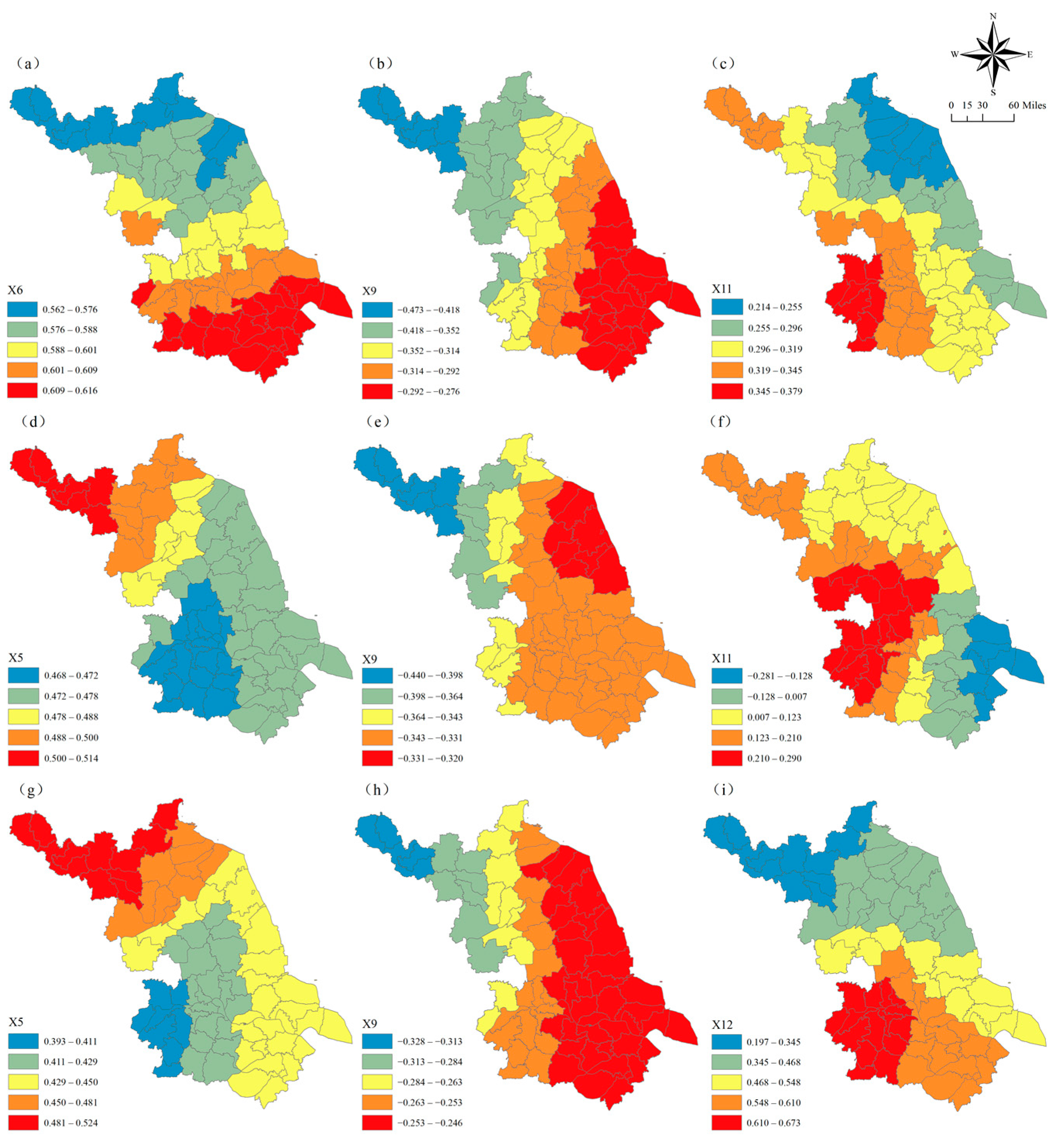
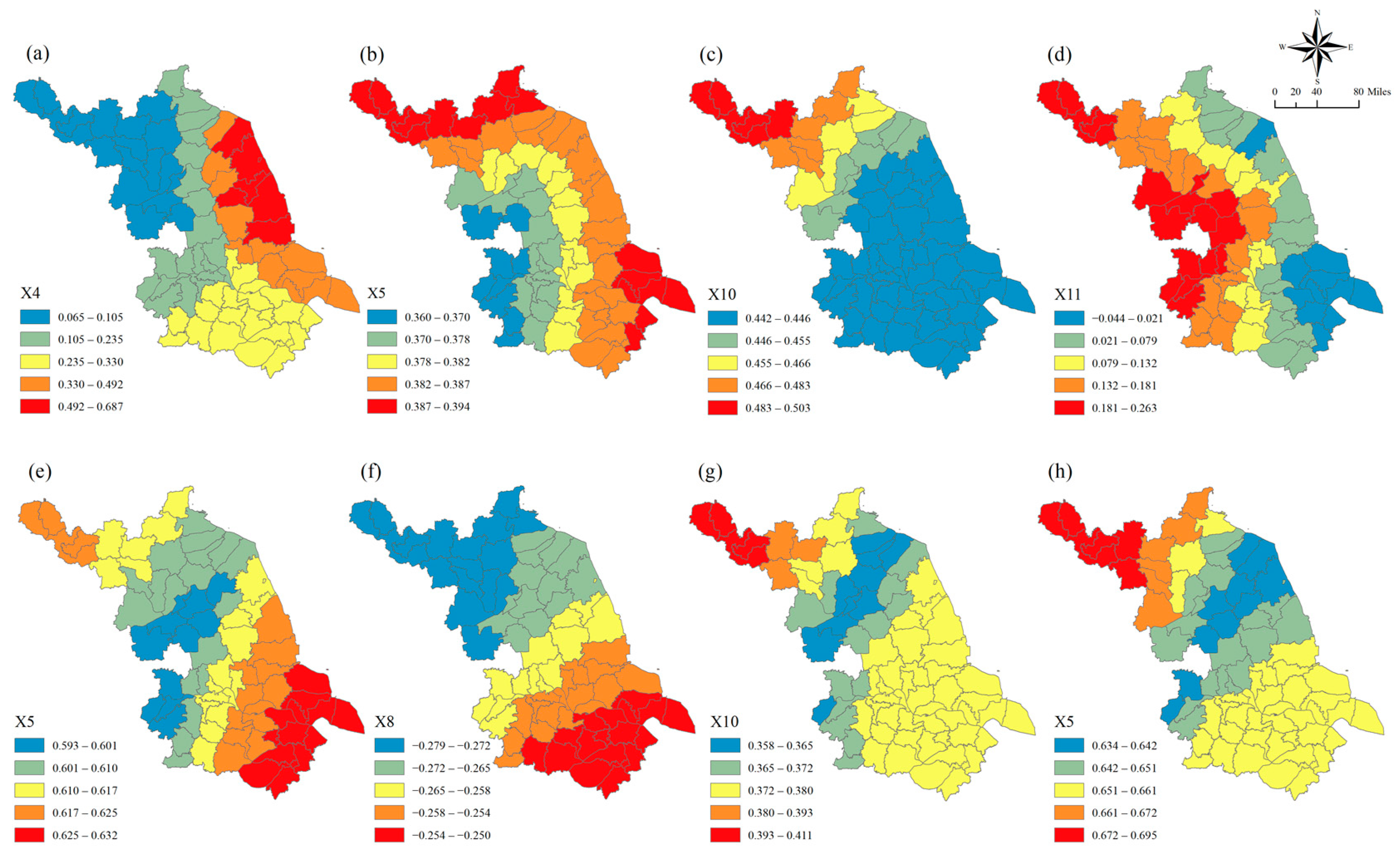
| Driving Factor | Variable Description | Unit | Predicted Relationship |
|---|---|---|---|
| Social development | |||
| Total population (X1) | Resident population of districts and counties | Persons | + |
| Urbanization rate (X2) | Urban resident population as a proportion of the total population | % | + |
| Rural Registered-Resident Population Discrepancy (X3) | Rural Registered Population-Rural Resident Population | 10 thousand people | + |
| Per capita cultivated land area (X4) | Total cultivated land area in the county/Total population | Khm2 | ± |
| Economic factors | |||
| Total agricultural output value (X5) | Total agricultural output value, forestry, animal husbandry, and fisheries | Million CNY | + |
| Per capita disposable income of rural residents (X6) | Income obtained by rural residents in the county after initial distribution and redistribution | CNY per capita | ± |
| Proportion of non-agricultural income (X7) | Non-agricultural income/Disposable income of rural residents | % | + |
| Production conditions | |||
| Total agricultural machinery power (X8) | Total power of the machinery used in agriculture, forestry, animal husbandry, and fisheries in the county | MW | − |
| Rural electricity consumption (X9) | Total electricity consumption in rural areas of the county during a specific time period | MWh | ± |
| Agricultural fertilizer application (X10) | Total amount of fertilizer used in agricultural production in the county during a specific time period | Tons | + |
| Natural Endowments | |||
| Elevation (X11) | Mean elevation of districts and counties | m | + |
| Annual mean precipitation (X12) | Mean annual precipitation of districts and counties | mm | + |
| Annual mean temperature (X13) | Mean annual temperature of districts and counties | °C | − |
| Dependent Variable | Non-Grainization Rate of Cultivated Land | ||||||
|---|---|---|---|---|---|---|---|
| Year | Independent Variable | MLR | MGWR | ||||
| Coefficient | T Value | VIF | Mean | Minimum | Maximum | ||
| 2001 | Constant | 1.3 | −0.0 | −0.0 | 0.0 | ||
| X1 | 0.2 | 1.5 | 2.6 | 0.2 | 0.2 | 0.2 | |
| X2 | 0.3 | 1.7 | 3.7 | 0.3 | 0.3 | 0.6 | |
| X3 | −0.0 | −0.3 | 1.9 | −0.0 | −0.0 | 0.0 | |
| X4 | 0.2 | 1.3 | 2.2 | 0.3 | 0.3 | 0.4 | |
| X5 | 0.1 | 0.2 | 5.7 | −0.0 | −0.0 | 0.0 | |
| X6 | 0.6 ** | 2.6 | 7.0 | 0.6 | 0.6 | 0.6 | |
| X7 | −0.1 | 0.6 | 2.5 | 0.0 | 0.0 | 0.0 | |
| X8 | −0.2 | −1.5 | 2.2 | −0.3 | −0.3 | −0.3 | |
| X9 | −0.6 ** | −2.9 | 4.6 | −0.3 | −0.3 | −0.3 | |
| X10 | 0.3 | 1.5 | 4.5 | 0.3 | 0.3 | 0.4 | |
| X11 | 0.4 *** | 3.6 | 1.4 | 0.3 | 0.3 | 0.4 | |
| X12 | 0.3 | 1.3 | 5.2 | 0.4 | 0.4 | 0.4 | |
| X13 | −0.2 | −0.9 | 4.4 | −0.4 | −0.3 | −0.0 | |
| Adj.R2 | 0.39 | 0.54 | |||||
| AIC | 179.2 | ||||||
| Function | Gaussian | ||||||
| 2010 | Constant | 11.9 | −0.3 | −0.3 | −0.2 | ||
| X1 | 0.2 | 1.2 | 2.3 | 0.2 | 0.1 | 0.2 | |
| X2 | 0.0 | 0.0 | 3.4 | 0.1 | −0.1 | 0.4 | |
| X3 | −0.1 | −0.8 | 3.1 | −0.1 | −0.4 | 0.1 | |
| X4 | −0.3 | −1.4 | 4.2 | −0.2 | −0.2 | −0.1 | |
| X5 | 0.5 ** | 2.9 | 4.6 | 0.5 | 0.5 | 0.5 | |
| X6 | 0.5 | 1.8 | 9.5 | 0.4 | 0.3 | 0.5 | |
| X7 | 0.1 | 0.8 | 4.4 | 0.1 | 0.0 | 0.1 | |
| X8 | −0.3 | −1.5 | 4.2 | −0.2 | −0.3 | −0.2 | |
| X9 | −0.4 ** | −2.8 | 3.5 | −0.3 | −0.4 | −0.3 | |
| X10 | 0.2 | 0.9 | 5.3 | 0.1 | 0.1 | 0.2 | |
| X11 | 0.2 * | 2.2 | 1.3 | 0.1 | −0.3 | 0.3 | |
| X12 | 0.2 | 1.3 | 2.8 | 0.3 | 0.1 | 0.4 | |
| X13 | 0.0 | 0.2 | 4.2 | −0.1 | −0.1 | −0.1 | |
| Adj.R2 | 0.44 | 0.55 | |||||
| AIC | 176.4 | ||||||
| Function | Gaussian | ||||||
| 2020 | Constant | 13.7 | −0.2 | −0.2 | −0.2 | ||
| X1 | 0.3 | 2.3 | 2.2 | 0.3 | 0.3 | 0.3 | |
| X2 | −0.1 | −0.7 | 4.8 | −0.0 | −0.0 | 0.0 | |
| X3 | −0.2 | −1.5 | 3.5 | −0.2 | −0.3 | −0.2 | |
| X4 | −0.2 | −1.8 | 3.3 | −0.1 | −0.1 | −0.1 | |
| X5 | 0.5 * | 2.5 | 6.4 | 0.4 | 0.4 | 0.5 | |
| X6 | 0.4 | 1.7 | 9.4 | 0.3 | 0.3 | 0.3 | |
| X7 | 0.1 | 1.0 | 2.0 | 0.2 | −0.0 | 0.3 | |
| X8 | −0.1 | −0.5 | 7.6 | −0.1 | −0.1 | −0.1 | |
| X9 | −0.3 * | −2.3 | 2.5 | −0.3 | −0.3 | −0.2 | |
| X10 | −0.1 | −0.6 | 4.4 | −0.2 | −0.3 | −0.1 | |
| X11 | 0.1 | 0.6 | 1.4 | −0.1 | −0.1 | 0.0 | |
| X12 | 0.3 * | 2.2 | 3.8 | 0.5 | 0.2 | 0.7 | |
| X13 | −0.1 | −0.6 | 4.2 | −0.2 | −0.2 | −0.2 | |
| Adj.R2 | 0.55 | 0.62 | |||||
| AIC | 163.1 | ||||||
| Function | Gaussian | ||||||
| Dependent Variable | Non-Grainization Area of Cultivated Land | ||||||
|---|---|---|---|---|---|---|---|
| Year | Independent Variable | MLR | MGWR | ||||
| Coefficient | T Value | VIF | Mean | Minimum | Maximum | ||
| 2001 | Constant | 2.6 | −0.1 | −0.1 | −0.1 | ||
| X1 | 0.1 | 1.1 | 2.6 | 0.1 | 0.1 | 0.1 | |
| X2 | 0.0 | 0.0 | 3.7 | 0.0 | −0.1 | 0.1 | |
| X3 | 0.0 | 0.4 | 1.9 | 0.0 | 0.0 | 0.1 | |
| X4 | 0.2 * | 2.6 | 2.2 | 0.3 | 0.1 | 0.7 | |
| X5 | 0.4 ** | 3.0 | 5.7 | 0.4 | 0.4 | 0.4 | |
| X6 | 0.2 | 1.4 | 7.0 | 0.1 | 0.0 | 0.1 | |
| X7 | 0.1 | 1.4 | 2.5 | 0.1 | 0.0 | 0.1 | |
| X8 | −0.1 | −1.7 | 2.2 | −0.2 | −0.2 | −0.2 | |
| X9 | −0.2 | −2.0 | 4.6 | −0.1 | −0.2 | −0.1 | |
| X10 | 0.5 *** | 4.3 | 4.5 | 0.5 | 0.4 | 0.5 | |
| X11 | 0.1 * | 2.1 | 1.4 | 0.1 | −0.0 | 0.2 | |
| X12 | 0.2 | 1.3 | 5.2 | 0.2 | 0.1 | 0.2 | |
| X13 | −0.1 | −0.8 | 4.4 | −0.0 | −0.1 | −0.0 | |
| Adj.R2 | 0.74 | 0.83 | |||||
| AIC | 100.0 | ||||||
| Function | Gaussian | ||||||
| 2010 | Constant | 8.0 | −0.0 | −0.0 | 0.0 | ||
| X1 | −0.0 | −0.5 | 2.3 | −0.0 | −0.1 | −0.0 | |
| X2 | 0.1 | 0.9 | 3.4 | 0.1 | 0.1 | 0.2 | |
| X3 | 0.2 | 1.9 | 3.1 | 0.2 | 0.1 | 0.2 | |
| X4 | 0.2 | 1.3 | 4.2 | 0.2 | 0.1 | 0.2 | |
| X5 | 0.7 *** | 4.8 | 4.6 | 0.6 | 0.6 | 0.6 | |
| X6 | 0.3 | 1.7 | 9.5 | 0.4 | 0.3 | 0.4 | |
| X7 | −0.0 | −0.0 | 4.4 | −0.1 | −0.1 | −0.1 | |
| X8 | −0.3 * | −2.5 | 4.2 | −0.3 | −0.3 | −0.3 | |
| X9 | −0.2 | −1.3 | 3.5 | −0.1 | −0.2 | −0.1 | |
| X10 | 0.4 * | 2.5 | 5.3 | 0.4 | 0.4 | 0.4 | |
| X11 | 0.1 | 1.8 | 1.3 | 0.2 | −0.2 | 0.4 | |
| X12 | −0.0 | −0.3 | 2.8 | 0.0 | −0.1 | 0.6 | |
| X13 | 0.1 | 0.6 | 4.2 | 0.0 | −0.0 | 0.0 | |
| Adj.R2 | 0.66 | 0.69 | |||||
| AIC | 148.2 | ||||||
| Function | Gaussian | ||||||
| 2020 | Constant | 7.7 | 0.0 | −0.0 | 0.0 | ||
| X1 | 0.0 | 0.4 | 2.2 | 0.0 | 0.0 | 0.1 | |
| X2 | −0.0 | −0.0 | 4.8 | 0.0 | −0.0 | 0.0 | |
| X3 | 0.1 | 0.5 | 3.5 | 0.1 | 0.0 | 0.1 | |
| X4 | 0.1 | 0.6 | 3.3 | 0.1 | −0.1 | 0.2 | |
| X5 | 0.8 *** | 4.3 | 6.4 | 0.7 | 0.6 | 0.7 | |
| X6 | 0.3 | 1.1 | 9.4 | 0.2 | 0.2 | 0.3 | |
| X7 | 0.2 | 1.9 | 2.0 | 0.1 | 0.1 | 0.2 | |
| X8 | −0.1 | −0.6 | 7.6 | −0.0 | −0.0 | 0.0 | |
| X9 | −0.1 | −0.6 | 2.5 | −0.1 | −0.1 | −0.1 | |
| X10 | 0.1 | 0.6 | 4.4 | 0.1 | 0.1 | 0.1 | |
| X11 | 0.1 | 1.2 | 1.4 | 0.1 | 0.0 | 0.1 | |
| X12 | −0.0 | −0.1 | 3.8 | 0.1 | 0.0 | 0.2 | |
| X13 | −0.2 | −1.2 | 4.2 | −0.2 | −0.3 | −0.2 | |
| Adj.R2 | 0.57 | 0.61 | |||||
| AIC | 164.1 | ||||||
| Function | Gaussian | ||||||
Disclaimer/Publisher’s Note: The statements, opinions and data contained in all publications are solely those of the individual author(s) and contributor(s) and not of MDPI and/or the editor(s). MDPI and/or the editor(s) disclaim responsibility for any injury to people or property resulting from any ideas, methods, instructions or products referred to in the content. |
© 2025 by the authors. Published by MDPI on behalf of the International Society for Photogrammetry and Remote Sensing. Licensee MDPI, Basel, Switzerland. This article is an open access article distributed under the terms and conditions of the Creative Commons Attribution (CC BY) license (https://creativecommons.org/licenses/by/4.0/).
Share and Cite
Chen, Y.; Xu, Y.; Ye, N. Geospatial Analysis of Regional Disparities in Non-Grain Cultivation: Spatiotemporal Patterns and Driving Mechanisms in Jiangsu, China. ISPRS Int. J. Geo-Inf. 2025, 14, 174. https://doi.org/10.3390/ijgi14040174
Chen Y, Xu Y, Ye N. Geospatial Analysis of Regional Disparities in Non-Grain Cultivation: Spatiotemporal Patterns and Driving Mechanisms in Jiangsu, China. ISPRS International Journal of Geo-Information. 2025; 14(4):174. https://doi.org/10.3390/ijgi14040174
Chicago/Turabian StyleChen, Yingxi, Yan Xu, and Nannan Ye. 2025. "Geospatial Analysis of Regional Disparities in Non-Grain Cultivation: Spatiotemporal Patterns and Driving Mechanisms in Jiangsu, China" ISPRS International Journal of Geo-Information 14, no. 4: 174. https://doi.org/10.3390/ijgi14040174
APA StyleChen, Y., Xu, Y., & Ye, N. (2025). Geospatial Analysis of Regional Disparities in Non-Grain Cultivation: Spatiotemporal Patterns and Driving Mechanisms in Jiangsu, China. ISPRS International Journal of Geo-Information, 14(4), 174. https://doi.org/10.3390/ijgi14040174





